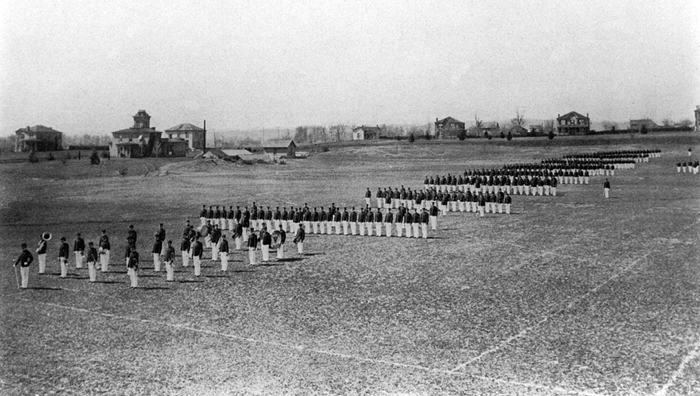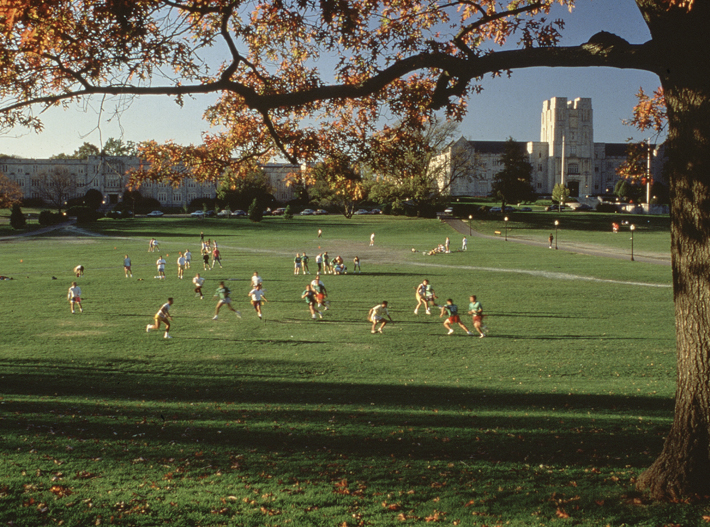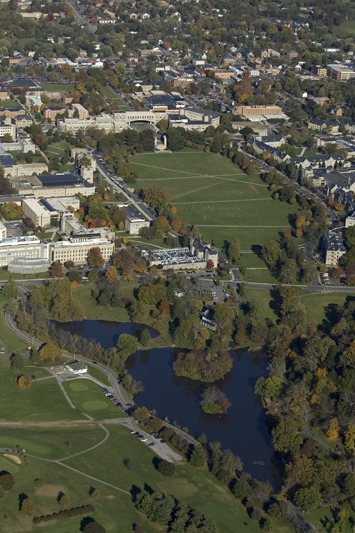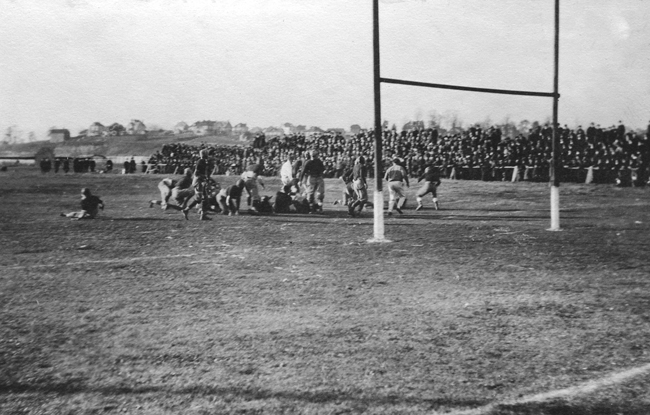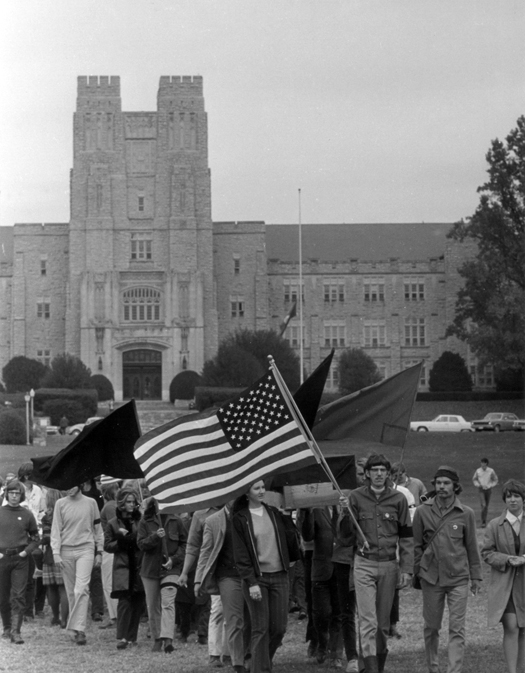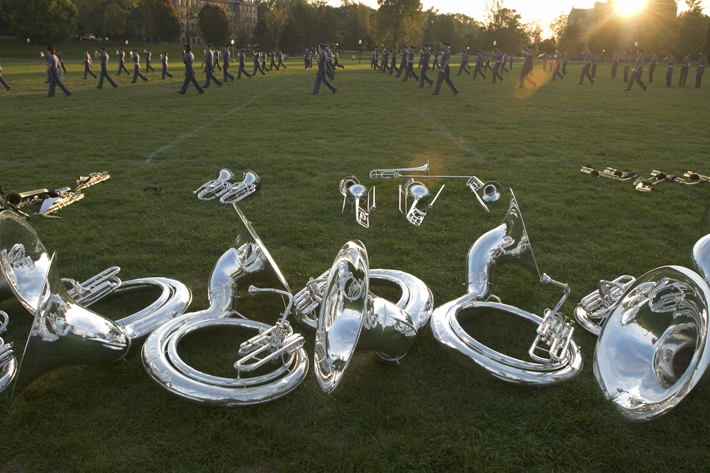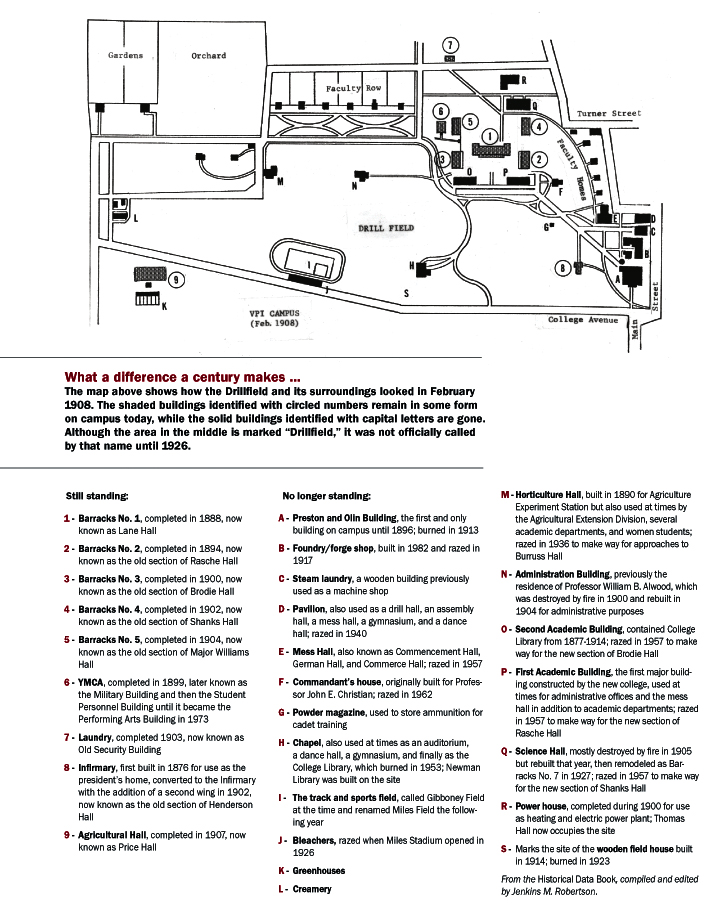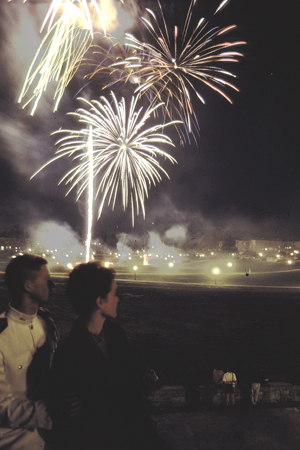 |
|
An oval-shaped, grassy stretch of land bordered by trees, Virginia Tech's Drillfield serves as the center of the Blacksburg campus and remains one of the most unique and storied locations at the university. Since 1894, the Drillfield has been the site of cadet maneuvers, sporting events, demonstrations, and displays of campus unity. Now, thousands of people come into contact with the Drillfield each day, students and faculty rushing to class crossing paths with visitors strolling around the central campus. Most of these individuals know that the Drillfield is an integral part of the Virginia Tech experience--but few know more than that. Sheib Field The property that includes the Drillfield was acquired by Virginia Agricultural and Mechanical College (VAMC, now Virginia Tech) in the late 19th century and initially was part of the horticulture farm. In 1894, VAMC President John M. McBryde offered a section of the area located in front of present-day Eggleston and War Memorial halls for use by both the military and athletic departments. According to Harry Temple in The Bugle's Echo, the small, ungraded area was "plowed, harrowed, and rolled, leaving the area raw, stony earth." It became known as Sheib Field, named for Edward E. Sheib, a professor of English and history who helped to financially support the football team. With the exception of tennis, all organized outdoor sports used the field, and its high side on the north became a favorite spot for spectators to sit. Temple says that in the first football season on the field, "the players spent much of their time during pauses in play gathering and removing stones from the surface." Through the years, the field was gradually improved and enlarged. Virginia Agricultural and Mechanical College and Polytechnic Institute (Virginia Tech's second name, which was shortened popularly to VPI) added a quarter-mile track around it in 1900 and, the following year, extended the track about 200 yards westward. The expansion of the field itself provided the corps of cadets with adequate space for its exercises. Occasionally, the area was also the scene of bonfires, a part of celebrations for everything from George Washington's birthday to a memorable Thanksgiving weekend and, later, pep rallies. Gibboney Field The college enlarged Sheib Field again in 1902 and erected a small wooden grandstand beside the track, which was extended to half a mile in circumference. The name of the site was changed to Gibboney Field in honor of James Haller Gibboney, the first graduate manager of athletics. Two years later, permanent bleachers, which seated 1,200 spectators, were constructed with funds supplied by the student newspaper, The Virginia Tech, specifically for that purpose. Student enrollment at the time was just under 730. To celebrate the improvements, the senior class took on the faculty in a baseball game, which the seniors won 9-8. Class versus class competitions in football were also held on Gibboney Field, beginning in 1904. In the first inter-class contests, the sophomores beat the freshmen 29-0, and the juniors-seniors game ended in a scoreless tie. In the play-offs, the freshmen defeated the juniors, and the sophomores whipped the seniors, making the second-year students the champions for that year. Gibboney Field underwent another remodeling in 1906, thanks to support from alumni and undergraduate fees. The $1,600 project provided a 550-foot-by-350-foot field for football and baseball and an even longer oval track around the perimeter. Miles Field
With substantial improvements in 1909 that included an enlarged grandstand and leveling and top-dressing--from three to nine inches of soil--the field underwent another name change: Miles Field, nicknamed Miles Meadow. The new namesake, Clarence Paul "Sally" Miles, was one of those rare individuals who had a seemingly unlimited supply of talent and skills. A VPI alumnus who had been captain of both the baseball and football teams, he was, at various times during his long career, business manager of the college newspaper, graduate manager of the Athletic Association, treasurer of the college, coach of the baseball and football teams, director of athletics, and a professor of modern languages, holding some of these jobs simultaneously. The first game on the improved and newly named field was a gridiron battle against Princeton, who squeaked by with a field goal in the final minute of play. In 1910, the mechanical faculty challenged the agricultural faculty to a football game, a struggle that had to be shortened because some of the players were not physically fit. Nonetheless, the engineers "skunked" the aggies 23-0. Perhaps the professors would have fared somewhat better had they waited two years to play their game; in 1912, the playing field for all gridiron matches was shortened from 110 yards to 100 yards. The field itself may have been saved forever by VPI's 1922 master plan, which encouraged development of the campus around the area rather than on it. Architect Warren Manning proposed that the 22-acre field be "an expanse to be left open forever," and his wishes have now dominated for 86 years. Not long after VPI approved the 1922 master plan, the college began feeling the need for a real stadium to better serve its growing athletics programs, and officials selected a site across the road from Miles Field for the new facility. When the project commenced in 1923, the Department of Civil Engineering supervised construction. Drillfield About the time the stadium was completed in 1926, the corps of cadets unanimously voted to name it Miles Stadium in honor of Sally Miles. Organized athletics severed ties to Miles Field as sporting events moved to the new facility. The great oval then became known simply as the Drillfield, reflecting the major use it would now serve, and the name stuck. One distinguishing characteristic of the Drillfield is the waterway--Stroubles Creek--running beneath its surface on the south side. The creek was enclosed in a conduit in 1934, and the first asphalt walks--two of them--were poured in 1971. Sinking, however, is not one of the Drillfield's characteristics. The urban legend that it subsides an inch per year is simply that, a legend with no basis in fact. Historic happenings
As early as 1898, the field became the site of countless snow battles. In the first years of the annual event, freshmen (then called "rats") were divided into two groups to hurl snowballs at each other while the rest of the corps and a number of other spectators watched from the fringes of the battle. Later, the snowball fights encompassed the entire corps, although President Paul B. Barringer called a temporary halt to them in 1910 because of the prevalence of pneumonia on campus. The Drillfield has seen a wide array of other extracurricular activities through the years. In the 1960s, students laden with signs of protest took to the field to demonstrate against the unpopular war in Vietnam--a move solidifying them with student unrest throughout the country. In 1997, approximately 3,000 students and faculty and staff members gathered on the Drillfield to celebrate the university's 125th anniversary by forming the numbers "125"; the image was photographed from a passing airplane. After the tragedy of April 16, 2007, the Drillfield became the spontaneous site of numerous memorials to the 32 students and professors who died and a gathering place for students, faculty and staff members, and countless others mourning those who had been lost. In November 2007, the field hosted thousands of people who spelled out a message of thanks to the world for the overwhelming support received in the wake of April 16. [See "Around the Drillfield."] Throughout its existence and regardless of its name, the Drillfield has served as a place of athletic rivalries, corps drills and reviews, celebrations, and memorials, proving time and time again that it is, indeed, the heart of the Virginia Tech campus.
|
|||||||||||||||||||||||||||||||||||
